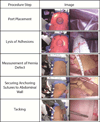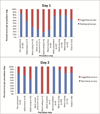The use of error analysis to assess resident performance
- PMID: 26003910
- PMCID: PMC4604013
- DOI: 10.1016/j.surg.2015.04.010
The use of error analysis to assess resident performance
Abstract
Background: The aim of this study was to assess validity of a human factors error assessment method for evaluating resident performance during a simulated operative procedure.
Methods: Seven postgraduate year 4-5 residents had 30 minutes to complete a simulated laparoscopic ventral hernia (LVH) repair on day 1 of a national, advanced laparoscopic course. Faculty provided immediate feedback on operative errors and residents participated in a final product analysis of their repairs. Residents then received didactic and hands-on training regarding several advanced laparoscopic procedures during a lecture session and animate lab. On day 2, residents performed a nonequivalent LVH repair using a simulator. Three investigators reviewed and coded videos of the repairs using previously developed human error classification systems.
Results: Residents committed 121 total errors on day 1 compared with 146 on day 2. One of 7 residents successfully completed the LVH repair on day 1 compared with all 7 residents on day 2 (P = .001). The majority of errors (85%) committed on day 2 were technical and occurred during the last 2 steps of the procedure. There were significant differences in error type (P ≤ .001) and level (P = .019) from day 1 to day 2. The proportion of omission errors decreased from day 1 (33%) to day 2 (14%). In addition, there were more technical and commission errors on day 2.
Conclusion: The error assessment tool was successful in categorizing performance errors, supporting known-groups validity evidence. Evaluating resident performance through error classification has great potential in facilitating our understanding of operative readiness.
Copyright © 2015 Elsevier Inc. All rights reserved.
Figures
Similar articles
-
Exploring Senior Residents' Intraoperative Error Management Strategies: A Potential Measure of Performance Improvement.J Surg Educ. 2016 Nov-Dec;73(6):e64-e70. doi: 10.1016/j.jsurg.2016.05.016. Epub 2016 Jun 29. J Surg Educ. 2016. PMID: 27372272 Review.
-
Use of error management theory to quantify and characterize residents' error recovery strategies.Am J Surg. 2020 Feb;219(2):214-220. doi: 10.1016/j.amjsurg.2019.11.013. Epub 2019 Nov 19. Am J Surg. 2020. PMID: 31806167
-
Do errors and critical events relate to hernia repair outcomes?Am J Surg. 2017 Apr;213(4):652-655. doi: 10.1016/j.amjsurg.2016.11.020. Epub 2016 Nov 17. Am J Surg. 2017. PMID: 27998548
-
Shortcut assessment: Can residents' operative performance be determined in the first five minutes of an operative task?Surgery. 2018 Jun;163(6):1207-1212. doi: 10.1016/j.surg.2018.02.012. Epub 2018 May 1. Surgery. 2018. PMID: 29728259
-
Relationship Between Technical Errors and Decision-Making Skills in the Junior Resident.J Surg Educ. 2016 Nov-Dec;73(6):e84-e90. doi: 10.1016/j.jsurg.2016.08.004. Epub 2016 Sep 23. J Surg Educ. 2016. PMID: 27671618 Free PMC article. Review.
Cited by
-
Impact of practicing internal benchmarking on continuous improvement of cataract surgery outcomes: a retrospective observational study at Aravind Eye Hospitals, India.BMJ Open. 2023 Jun 22;13(6):e071860. doi: 10.1136/bmjopen-2023-071860. BMJ Open. 2023. PMID: 37349104 Free PMC article.
-
Distinguishing Intermediate and Novice Surgeons by Eye Movements.Front Psychol. 2020 Sep 10;11:542752. doi: 10.3389/fpsyg.2020.542752. eCollection 2020. Front Psychol. 2020. PMID: 33013592 Free PMC article.
References
-
- Mattar SG, Alseidi AA, Jones DB, et al. General surgery residency inadequately prepares trainees for fellowship: results of a survey of fellowship program directors. Ann Surg. 2013;258:440–449. - PubMed
-
- Richardson JD. ACS transition to practice program offers residents additional opportunities to hone skils. [Accessed March 6th 2014];The Bulletin of the American College of Surgeons. 2013 Available at http://bulletin.facs.org/2013/09/acs-transition-to-practice-program-offe.... - PubMed
-
- Hoyt BD. Executive Director’s report: Looking forward - February 2013. [Accessed March 6th 2014];Bulletin of the American College of Surgeons. 2013 Available at http://bulletin.facs.org/2013/02/looking-forward-february-2013/.
-
- Bucholz EM, Sue GR, Yeo H, Roman SA, Bell RH, Jr, Sosa JA. Our trainees' confidence: results from a national survey of 4136 US general surgery residents. Arch Surg. 2011;146:907–914. - PubMed
-
- Coleman JJ, Esposito TJ, Rozycki GS, Feliciano DV. Early subspecialization and perceived competence in surgical training: are residents ready? J Am Coll Surg. 2013;216:764–771. discussion 71–3. - PubMed
Publication types
MeSH terms
Grants and funding
LinkOut - more resources
Full Text Sources
Other Literature Sources
Miscellaneous




